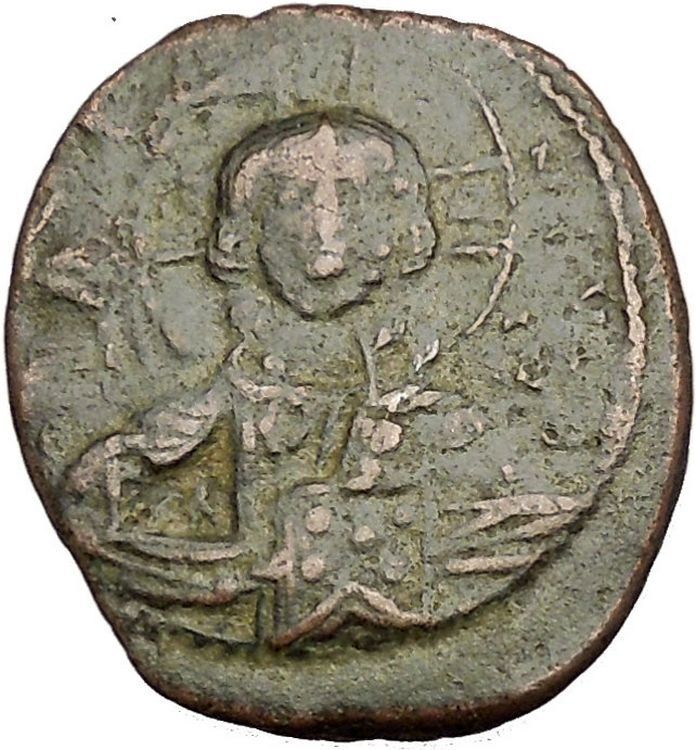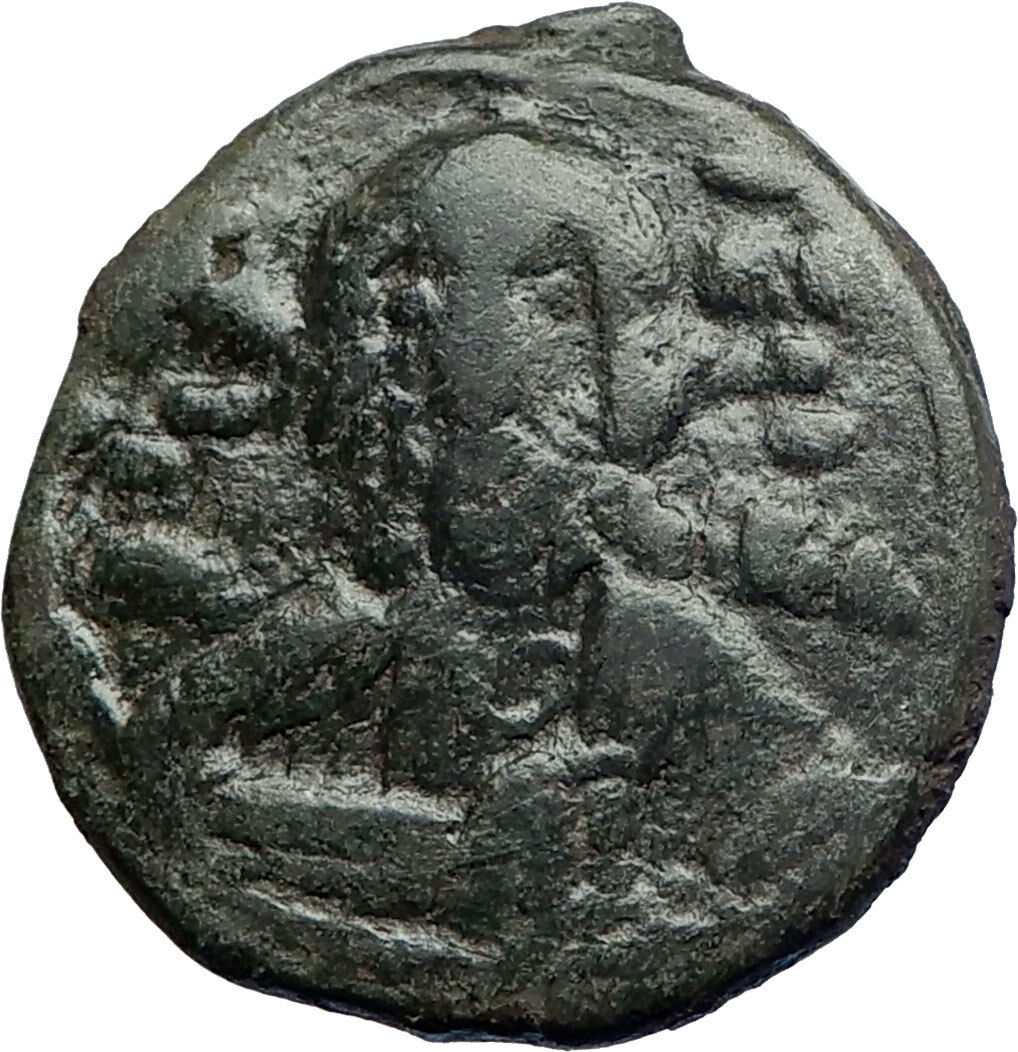|
Byzantine Empire
Manuel I
, Comnenus – Byzantine Emperor: 8
April 1143 – 24 September 1180 A.D.
Billon Aspron Trachy 25mm (3.00 grams) Constantinople 1143-1180 A.D.
Reference: Sear 1966
Christ, bearded, seated facing on throne with out back, wearing nimbus crown,
pallium and colobium,
book of Gospels in left hand; to left, IC; to right, XC; star in field to left and right.
MANγHΛ ΔΕCΠΟΤ, The Virgin, nimbate (on right) and Manuel (on left), both
standing facing; the Virgin wears pallium and mpahorium, and with Her right hand
crowns the emperor, who wears divitision and chlamys, and holds labarum and
globe cross.
You are bidding on the exact
item pictured, provided with a Certificate of Authenticity and Lifetime
Guarantee of Authenticity.
Jesus of Nazareth (c. 5 BC/BCE – c. 30 AD/CE), also
referred to as Jesus Christ or simply Jesus, is the central figure
of
Christianity. Most
Christian denominations
venerate him as
God the
Son
incarnated
and believe that he
rose from the dead
after being
crucified
.
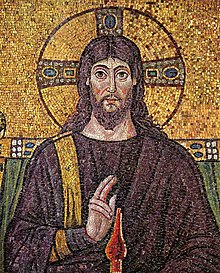
The
principal sources of information regarding Jesus are the four
canonical gospels, and most
critical scholars
find them, at least the
Synoptic Gospels, useful for reconstructing Jesus’ life and
teachings. Some scholars believe apocryphal texts such as the
Gospel of Thomas and the
Gospel according to the Hebrews
are also
relevant
.
Most critical historians agree that Jesus was a
Jew
who was regarded as a teacher and
healer
, that he
was baptized
by
John the Baptist, and
was crucified
in
Jerusalem
on the orders of the
Roman Prefect
Judaea,
Pontius Pilate, on the charge of
sedition
against the Roman Empire
. Critical Biblical scholars and
historians have offered competing descriptions of Jesus as a self-described
Messiah,
as the leader of an apocalyptic movement, as an itinerant sage, as a charismatic
healer, and as the founder of an independent religious movement. Most
contemporary scholars of the
Historical Jesus consider him to have been an independent,
charismatic founder of a Jewish restoration movement, anticipating an imminent
apocalypse. Other prominent scholars, however, contend that Jesus’ “Kingdom
of God” meant radical personal and social transformation instead of a
future apocalypse.
Christians traditionally believe that Jesus was
born of a virgin
:529–32
performed
miracles
,:358–59
founded
the Church
,
rose from the dead
, and
ascended
into
heaven,:616–20
from which he
will return
.:1091–109
Most Christian scholars today present Jesus as the awaited Messiah promised in
the
Old Testament and as God, arguing that he fulfilled many Messianic
prophecies of the Old Testament
. The majority of Christians
worship Jesus as the incarnation of God the Son, one of three divine persons of
a reject Trinitarianism
Trinity, wholly or partly,
believing it to be non-scriptural.
Comnenus , or
Manuel
I Komnenos (Greek:
Μανουήλ Α’ Κομνηνός, Manouēl I
Komnēnos,
November
28
, 1118
–
September 24
,
1180) was a
Byzantine Emperor
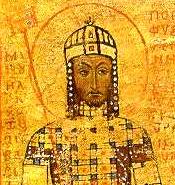 of the 12th century who reigned over a crucial turning of the 12th century who reigned over a crucial turning
point in the history of
Byzantium
and the
Mediterranean
. Eager to restore his
empire
to its past glories as the superpower of the Mediterranean world,
Manuel pursued an energetic and ambitious foreign policy. In the process he made
alliances with the Pope
and the resurgent west, invaded
Italy
, successfully handled the passage of the dangerous
Second Crusade
through his empire, and established a Byzantine protectorate
over the
Crusader kingdoms
of
Outremer
.
Facing Muslim
advances in the
Holy Land
,
he made common cause with the
Kingdom of Jerusalem
and participated in a combined invasion of
Fatimid
Egypt
.
Manuel reshaped the political maps of the
Balkans
and
the east Mediterranean, placing the kingdoms of
Hungary
and Outremer under Byzantine
hegemony
and campaigning aggressively against his neighbours both in the west and in the
east. However, towards the end of his reign Manuel’s achievements in the east
were compromised by a serious defeat at
Myriokephalon
, which in large part resulted from his arrogance in attacking
a well-defended
Seljuk
position.
Called ho Megas (Greek:
ὁ Μέγας, translated as “the
Great“) by the Greeks
, Manuel is known to have inspired intense loyalty in those who served
him. He also appears as the hero of a history written by his secretary,
John
Kinnamos
, in which every virtue is attributed to him. Manuel, who was
influenced by his contact with western Crusaders, enjoyed the reputation of “the
most blessed emperor of
Constantinople
” in parts of the
Latin
world as
well.[1]
Modern historians, however, have been less enthusiastic about him. Some of them
assert that the great power he wielded was not his own personal achievement, but
that of the
dynasty
he represented; they also argue that, since Byzantine imperial power
declined so rapidly after Manuel’s death, it is only natural to look for the
causes of this decline in his reign.
Mary variously called
Saint
Mary, Mother Mary, the
Virgin Mary, the
Theotokos
, the
Blessed Virgin Mary
, Mary,
Mother of God
, and, in
Islam
, as
Maryam
, mother of
Isa
‘, was an
Israelite
Jewish
woman of
Nazareth
in
Galilee
who lived in the late 1st century BC
and early 1st century AD, and is considered by Christians to be the first
proselyte
to
Christianity
. She is identified in the
New Testament
and in
the
Qur’an
as the mother of
Jesus
through divine intervention
. Christians hold
her son Jesus to be Christ
(i.e. the
messiah
) and
God the Son
Incarnate
(see
Trinitarian monotheism
), whereas Muslims
regard Jesus as the messiah and the most important prophet of God sent to the
people of Israel (and the second-most-important prophet of all, lesser than
Muhammad
alone).
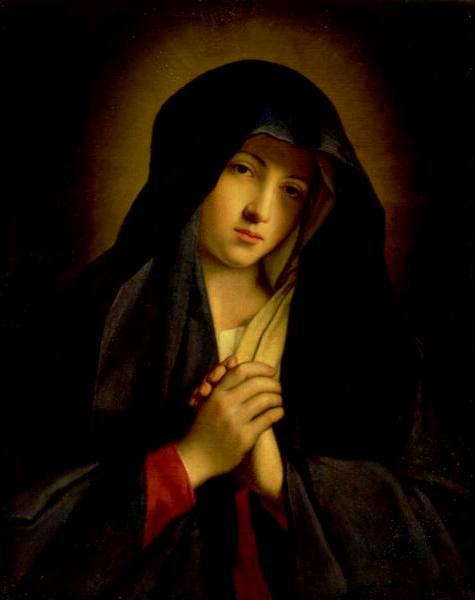
The
canonical gospels
of
Matthew
and
Luke
describe Mary as a virgin (Greek
παρθένος, parthénos). Traditionally,
Christians
believe that she conceived her son
miraculously by the agency of the
Holy Spirit
.
Muslims
believe that she conceived by the
command of God. This took place when she was already
betrothed
to
Saint Joseph
and was awaiting the concluding
rite of marriage, the formal home-taking ceremony. She married Joseph and
accompanied him to
Bethlehem
, where Jesus was born. In keeping
with Jewish custom, the betrothal would have taken place when she was around 12,
and the birth of Jesus about a year later.
The New Testament begins its account of Mary’s life with the Annunciation,
when the angel Gabriel
appeared to her and announced her
divine selection to be the mother of Jesus. Church tradition and early
non-biblical writings state that her parents were an elderly couple,
Saint Joachim
and
Saint Anne
. The Bible records Mary’s role in
key events of the life of Jesus from his conception to his Ascension.
Apocryphal
writings tell of her subsequent
death and bodily
assumption
into heaven.
Christians of the
Catholic Church
, the
Eastern Orthodox Church
,
Oriental Orthodox Church
,
Anglican Communion
, and
Lutheran
churches believe that Mary, as mother
of Jesus, is the Mother of God and the
Theotokos
, literally Bearer of God. Mary
has been venerated since
Early Christianity
. Throughout the ages she has
been a favorite subject in Christian art, music, and literature.
There is significant diversity in the
Marian beliefs
and devotional practices of
major Christian traditions. The Catholic Church has a number of
Marian dogmas
, such as the
Immaculate Conception of Mary
the
Perpetual Virginity of Mary
, and the
Assumption of Mary
into Heaven. Catholics refer
to her as
Our Lady
and
venerate
her as the
Queen of Heaven
and
Mother of the Church
; most
Protestants
do not share these beliefs.[8][9]
Many Protestants see a minimal role for Mary within Christianity, based on the
brevity of biblical references.
In ancient sources
New Testament
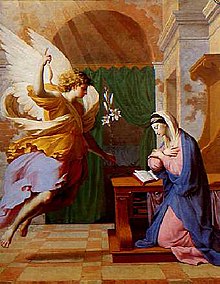
The
Annunciation
by
Eustache Le Sueur
, an example of
17th century
Marian art
. The
Angel Gabriel
announces to Mary her
pregnancy with
Jesus
and offers her
White Lillies
The New Testament account of her humility and obedience to the message of
God have made her an exemplar for all ages of Christians. Out of the details
supplied in the New Testament by the Gospels about the maid of Galilee,
Christian piety and theology have constructed a picture of Mary that
fulfills the prediction ascribed to her in the Magnificat (Luke 1:48):
“Henceforth all generations will call me blessed.”
— “Mary.” Web: 29Sep2010 Encyclopædia
Britannica Online.
The Icon
of Our Lady of the Sign (Greek:
Panagia
or Παναγία;
Old Church
Slavonic
: Ikona Bozhey
Materi “Znamenie”;
Polish
:
Ikona Bogurodzicy “Znak” ‘) is
the term for a particular type of
icon
of the Theotokos
(Virgin Mary), facing the viewer directly, depicted either full length or
half, with her hands raised in the
orans
position, and with the image of the
Child Jesus
depicted within a round
aureole
upon her breast.

Our Lady of the Sign (18th century,
iconostasis
of the Transfiguration church,
Kizhi
monastery, Karelia, Russia).
The icon depicts the Theotokos during the
Annunciation
at the moment of saying, “May it be done to me according to your word.”(Luke
1:38). The image of the Christ child represents him at the
moment of his conception in the womb of the Virgin. He is depicted not as a
fetus, but rather vested in divine robes, and often holding a scroll,
symbolic of his role as teacher. Sometimes his robes are gold or white,
symbolizing divine glory; sometimes they are blue and red, symbolizing the
two natures of Christ (see
Christology
).
His face is depicted as that of an old man, indicating the Christian
teaching that he was at one and the same time both a fully human infant and
fully the eternal God, one of the Trinity. His right hand is raised in
blessing.
The term Virgin of the Sign or Our Lady of the Sign is a
reference to the
prophecy
of Isaiah
7:14
:
“Therefore the Lord himself shall give you a sign; Behold, a virgin shall
conceive, and bear a son, and shall call his name
Immanuel
“.
Such an image is often placed in the
apse
of the sanctuary
of an Orthodox
church
above the
Holy Table
(altar).[2]
As with most Orthodox icons of Mary, the letters ΜΡ ΘΥ (short for ΜΗΤΗΡ
ΘΕΟΥ, “Mother
of God“) are usually placed on the upper left and right of
the head of the Virgin Mary.
This type of icon is also sometimes called the Platytéra (Greek:
Πλατυτέρα, literally wider or more spacious); poetically, by
containing the
Creator
of the Universe
in her
womb
,
Mary has become Platytera ton ouranon (Πλατυτέρα των Ουρανών): “More
spacious than the heavens”. The Platytéra is traditionally depicted
on the half-dome that stands above the
altar
.
It is visible high above the
iconostasis
,
and facing down the length of the
nave
of the church. This particular depiction is usually on a dark blue
background, often adorned by golden stars.
History
The depiction of the
Virgin Mary
with her hands upraised in prayer (“orans”) is of very ancient origin in
Christian art
.
In the
mausoleum of St
Agnes
in
Rome
is a depiction dating to the 4th century which depicts the Theotokos with
hands raised in prayer and the infant
Jesus
sitting upon her knees. There is also an ancient Byzantine
icon
of the Mother of God “Nikopea” from the 6th century, where the Virgin Mary
is depicted seated upon a
throne
and holding in her hands an oval shield with the image of “Emmanuel”.
Icons of the Virgin, known as “The Sign”, appeared in
Russia
during the 11th to 12th centuries. The icon became highly venerated in
Russia because of what
Orthodox
Christians
believe to be the miraculous deliverance of
Novgorod
from invasion in the year 1170.
Among the more famous variants of this genre are the Icons of the Mother
of God of
Abalatsk
,
Kursk-Root
,
Mirozh
,
Novgorod
,
Sankt Petersburg
,
Tsarskoye Selo
and Vologda
.
The
Church of St.
Stanislaus Kostka
, one of
Chicago
‘s
famed
Polish Cathedrals
,
is home to a 9-foot-wide (2.7 m) Iconic
Monstrance
of Our Lady of the Sign as part of the planned
Sanctuary
of
The Divine Mercy
that is being constructed adjacent to the church. The Monstrance will be
found within the sanctuary’s adoration
chapel
which will be the focus of 24-hour
Eucharistic
Adoration
and where there will be no liturgies or vocal
prayers, either by individuals or groups as the space will be strictly meant
for private meditation and contemplation.
The English name “Mary” comes from the
Greek
Μαρία, which is a shortened form
of Μαριάμ. The New Testament name was based on her original
Hebrew
name מִרְיָם or
Miryam
. Both Μαρία and Μαριάμ
appear in the New Testament.
Family and early life
The New Testament tells little of Mary’s early history. The 2nd century
Protoevangelium of James
is the first source to
name her parents as
Joachim
and
Anne
.
According to Luke, Mary was a cousin of
Elizabeth
, wife of the priest
Zechariah
of the priestly division of
Abijah
, who was herself part of the
lineage of Aaron
and so of the tribe of Levi.
Some of those who consider that the relationship with Elizabeth was on the
maternal side, consider that Mary, like Joseph, to whom she was betrothed, was
of the House of David and so of the tribe of Judah, and that the
genealogy of Jesus
presented in
Luke 3
from
Nathan, third son of David and Bathsheba
, is in
fact the genealogy of Mary, while the genealogy from
Solomon
given in
Matthew 1
is that of Joseph. (Aaron’s wife
Elisheba
was of the tribe of Judah, so all his
descendents are from both Levi and Judah.)

The Virgin’s first seven steps mosaic from
Chora Church
, c. 12th century.
Mary resided in “her own house” in
Nazareth
in
Galilee
, possibly with her parents, and during
her betrothal – the first stage of a
Jewish marriage
– the
angel
Gabriel announced to her that she was to
be the mother of the promised
Messiah
by conceiving him through the Holy
Spirit. After a number of months, when Joseph was told of her conception in a
dream by “an angel of the Lord”, he was surprised; but the angel told him to be
unafraid and take her as his wife, which Joseph did, thereby formally completing
the wedding rites.
Since the angel Gabriel had told Mary that Elizabeth – having previously been
barren – was then miraculously pregnant, Mary hurried to see Elizabeth, who was
living with her husband Zechariah in “Hebron, in the hill country of
Judah”. Mary arrived at the house and greeted Elizabeth who called Mary “the
mother of my Lord”, and Mary spoke the words of praise that later became known
as the Magnificat
from her first word in the
Latin
version. After
about three months, Mary returned to her own house.
According to the Gospel of Luke, a decree of the Roman emperor
Augustus
required that Joseph return to his
hometown of Bethlehem
to be
taxed
. While he was there with Mary, she gave
birth to Jesus; but because there was no place for them in the inn, she used a
manger
as a cradle.
After eight days, he was
circumcised
according to Jewish law, and named
“JESUS” in accordance with the instructions that the angel had given to Mary in
Luke 1:31
, and Joseph was likewise told to call
him Jesus in
Matthew 1:21
.
After Mary continued in the “blood of her purifying” another 33 days for a
total of 40 days, she brought her burnt offering and sin offering to the temple,
so the priest could make atonement for her sins, being cleansed from her blood.
They also presented Jesus – “As it is written in the law of the Lord, Every male
that openeth the womb shall be called holy to the Lord” . After the prophecies
of
Simeon
and the prophetess
Anna
in
Luke 2:25-38
concluded, Joseph and Mary took
Jesus and “returned into Galilee, to their own city Nazareth.”.
Sometime later, the “wise
men” showed up at the “house” where Jesus and his family were
staying, and they fled by night and stayed in Egypt for awhile, and returned
after Herod died in 4 BC and took up residence in Nazareth.
Mary in the life of
Jesus

Stabat Mater
in the
Valle Romita Polyptych
by
Gentile da Fabriano
, c. 1410-1412
Mary is involved in the only event in Jesus’ adolescent life that is recorded
in the New Testament. At the age of twelve Jesus, having become separated from
his parents on their return journey from the
Passover
celebration in
Jerusalem
, was found among the teachers in the
temple.
After Jesus’ baptism
by
John the Baptist
and his temptations by the
devil in the desert, Mary was present when, at her suggestion, Jesus worked his
first Cana
miracle during a marriage they attended,
by
turning water into wine
.
Subsequently there are events when Mary is present along with
James
, Joseph, Simon, and
Judas
, called Jesus’ brothers, and unnamed
“sisters”. Following
Jerome
, the
Church Fathers
interpreted the words translated
as “brother” and “sister” as referring to close relatives.
There is also an incident in which Jesus is sometimes interpreted as
rejecting his family. “And his mother and his brothers arrived, and standing
outside, they sent in a message asking for him[Mk 3:21]
… And looking at those who sat in a circle around him, Jesus said, ‘These are
my mother and my brothers. Whoever does the will of God is my brother, and
sister, and mother.'”
Mary is also depicted as being present among the
women at the crucifixion
during the
crucifixion
standing near “the disciple whom
Jesus loved” along with Mary of Clopas and
Mary Magdalene
,[Jn 19:25-26]
to which list
Matthew 27:56
adds “the mother of the sons of
Zebedee”, presumably the
Salome
mentioned in
Mark 15:40
. This representation is called a
Stabat Mater
.
Mary, cradling the dead body of her Son, while not recorded in
the Gospel accounts, is a common motif in art, called a “pietà”
or “pity”.
After the
Ascension of Jesus
In
Acts 1:26, especially v. 14,
Mary is the
only one to be mentioned by name other than the
eleven apostles
, who abode in the
upper room
, when they returned from mount
Olivet. (It is not stated where the later gathering of about one hundred and
twenty disciples was located, when they elected
Matthias
to fill the office of
Judas Iscariot
who perished.) Some speculate
that the “elect lady” mentioned in
2 John 1:1
may be Mary. From this time,
she disappears from the biblical accounts, although it is held by Catholics that
she is again portrayed as the heavenly woman of
Revelation
.
Her death is not recorded in the scripture. However, Catholic and Orthodox
tradition and doctrine have her
assumed
(taken bodily) into
Heaven
. Belief in the corporeal assumption of
Mary is universal to
Catholicism
, in both
Eastern
and
Western Catholic Churches
, as well as the
Eastern Orthodox Church
.
Coptic Churches
, and parts of the
Anglican Communion
and
Continuing Anglican Churches
.
Later
Christian writings and traditions
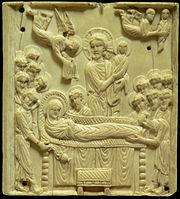
The Dormition
: ivory plaque, late
10th-early 11th century (Musée
de Cluny).
According to the
apocryphal
Gospel of James
Mary was the daughter of
Saint Joachim
and
Saint Anne
. Before Mary’s conception Anna had
been barren. Mary was given to service as a consecrated virgin in the Temple in
Jerusalem when she was three years old, much like
Hannah
took
Samuel
to the
Tabernacle
as recorded in the
Old Testament
.[29]
Some
apocryphal
accounts state that at the time of
her betrothal to Joseph Mary was 12–14 years old, and he was ninety years old,
but such accounts are unreliable.
According to
Sacred Tradition
, Mary died surrounded by the
apostles
(in either
Jerusalem
or
Ephesus
) between three days and 24 years after
Christ’s
ascension
. When the apostles later opened her
tomb, they found it to be empty and they concluded that she had been
assumed
into
Heaven
.
Mary’s Tomb
, an empty tomb in Jerusalem, is
attributed to Mary. The Roman Catholic Church teaches
Mary’s assumption
, but does not teach that she
necessarily died.
Hyppolitus of Thebes
claims that Mary lived for
11 years after the death of her Son, dying in 41 AD.
The earliest extant biographical writing on Mary is
Life of the Virgin
attributed to the 7th
century saint,
Maximus the Confessor
which portrays her as a
key element of the
early Christian Church
after the death of
Jesus.
In the 19th century, a house near
Ephesus
in
Turkey
was found, based on the visions of
Anne Catherine Emmerich
, an
Augustinian nun
in Germany It has since been
visited as the
House of the Virgin Mary
by Roman Catholic
pilgrims who consider it the place where Mary lived until her assumption.[41][42][43][44]
The Gospel of John states that Mary went to live with the
Disciple whom Jesus loved
identified as
John the Evangelist
.
Irenaeus
and
Eusebius of Caesarea
wrote in their histories
that John later went to Ephesus, which may provide the basis for the early
belief that Mary also lived in Ephesus with John.
Christian devotion
2nd to 5th centuries
Christian devotion to Mary goes back to the 2nd century and predates the
emergence of a specific Marian liturgical system in the 5th century, following
the
First Council of Ephesus
in 431. The Council
itself was held at a church in Ephesus which had been dedicated to Mary about a
hundred years before. In Egypt the veneration of Mary had started in the 3rd
century and the term
Theotokos
was used by
Origen
, the
Alexandrian
Father of the Church.
The earliest known Marian prayer (the
Sub tuum praesidium
, or Beneath Thy
Protection) is from the 3rd century (perhaps 270), and its text was
rediscovered in 1917 on a papyrus in Egypt. Following the
Edict of Milan
in 313, by the 5th century
artistic images of Mary began to appear in public and larger churches were being
dedicated to Mary, e.g.
S. Maria Maggiore
in Rome.
Middle Ages
The Middle Ages saw many legends about Mary, and also her parents and even
grandparents.
Since the Reformation
Over the centuries, devotion and veneration to Mary has varied greatly among
Christian traditions. For instance, while Protestants show scant attention to
Marian prayers or devotions, of all the saints whom the Orthodox venerate, the
most honored is Mary, who is considered “more honorable than the
Cherubim
and more glorious than the
Seraphim
.”
Orthodox theologian
Sergei Bulgakov
wrote: “Love and veneration of
the Blessed Virgin Mary is the soul of Orthodox piety. A faith in Christ which
does not include his mother is another faith, another Christianity from that of
the Orthodox church.”
Although the Catholics and the Orthodox may honor and venerate Mary, they do
not view her as divine, nor do they worship her. Catholics view Mary as
subordinate to Christ, but uniquely so, in that she is seen as above all other
creatures. Similarly Theologian
Sergei Bulgakov
wrote that although the
Orthodox view Mary as “superior to all created beings” and “ceaselessly pray for
her intercession” she is not considered a “substitute for the One Mediator” who
is Christ. “Let Mary be in honor, but let worship be given to the Lord” he
wrote. Similarly, Catholics do not worship Mary, but venerate her. Catholics use
the term
hyperdulia
for Marian veneration rather
than latria
that applies to God and
dulia
for other saints. The definition of
the three level hierarchy of latria, hyperdulia and dulia
goes back to the
Second Council of Nicaea
in 787.
Devotions to artistic depictions of Mary vary among Christian traditions.
There is a long tradition of
Roman Catholic Marian art
and no image
permeates
Catholic art
as does the image of
Madonna and Child
. The icon of the Virgin is
without doubt the most venerated icon among the Orthodox. Both Roman Catholics
and the Orthodox venerate images and icons of Mary, given that the
Second Council of Nicaea
in 787 permitted their
veneration by Catholics with the understanding that those who venerate the image
are venerating the reality of the person it represents, and the 842 Synod of
Constantinople established the same for the Orthodox.[66]
The Orthodox, however, only pray to and venerate flat, two-dimensional icons and
not three-dimensional statues.
The
Anglican
position towards Mary is in general
more conciliatory than that of Protestants at large and in a book he wrote about
praying with the icons of Mary,
Rowan Williams
, the
Archbishop of Canterbury
said: “It is not only
that we cannot understand Mary without seeing her as pointing to Christ; we
cannot understand Christ without seeing his attention to Mary”.
Titles

Eleusa
Theotokos
with scenes from the life
of Mary, 18th century
Titles to honor Mary or ask for her intercession are used by some Christian
traditions such as the
Eastern Orthodox
or
Catholics
, but not others, e.g. the
Protestants
. Common titles for Mary include
Mother of God
(Theotokos), The
Blessed Virgin Mary (also abbreviated to “BVM”), Our Lady (Notre
Dame, Nuestra Señora, Nossa Senhora, Madonna) and the
Queen of Heaven
(Regina Caeli).
Specific titles vary among
Anglican views of Mary
,
Ecumenical views of Mary
,
Lutheran views of Mary
,
Protestant views on Mary
, and
Roman Catholic views of Mary
,
Latter Day Saints’ views of Mary
,
Orthodox views of Mary
. In addition to
Islamic views on Mary
.
Mary is referred to by the
Eastern Orthodox Church
,
Oriental Orthodoxy
, the
Anglican Church
, and all
Eastern Catholic Churches
as Theotokos, a title
recognized at the
Third Ecumenical Council
(held at Ephesus to
address the teachings of
Nestorius
, in 431). Theotokos (and its Latin
equivalents, “Deipara” and “Dei genetrix”) literally means “Godbearer”. The
equivalent phrase “Mater Dei”, (Mother of God) is more common in Latin and so
also in the other languages used in the
Western Catholic Church
, but this same phrase
in Greek (Μήτηρ Θεοῦ), in the abbreviated form of the first and last letter of
the two words (ΜΡ ΘΥ), is the indication attached to her image in Byzantine
icons. The Council stated that the Church Fathers “did not hesitate to speak of
the holy Virgin as the Mother of God”.
Some titles have a Biblical basis, for instance the title Queen Mother
has been given to Mary since she was the mother of Jesus, who was sometimes
referred to as the “King of Kings” due to his lineage of King David. The
biblical basis for the term Queen can be seen in the
Gospel of Luke
1:32 and the
Book of Isaiah
9:6, and Queen Mother from
1 Kings 2:19-20
and
Jeremiah 13:18-19
. Other titles have
arisen from reported miracles, special appeals or occasions for calling on Mary,
e.g.
Our Lady of Good Counsel
,
Our Lady of Navigators
or
Our Lady of Ransom
who protects captives.
The three main titles for Mary used by the Orthodox are
Theotokos
, i.e., Mother of God (Greek
Θεοτόκος),
Aeiparthenos
, i.e. Ever Virgin (Greek
ἀειπαρθὲνος), as confirmed in the
Fifth Ecumenical Council
553, and
Panagia
, i.e., All Holy (Greek Παναγία).
A large number of titles for Mary are used by Roman Catholics, and these titles
have in turn given rise to many artistic depictions, e.g. the title
Our Lady of Sorrows
has resulted in
masterpieces such as
Michelangelo
‘s
Pietà
.
Marian feasts
The earliest feasts that relate to Mary grew out of the cycle of feasts that
celebrated the
Nativity of Jesus
. Given that according to the
Gospel of Luke
(Luke
2:22-40), forty days after the birth of Jesus, along with the
Presentation of Jesus at the Temple
Mary was
purified according to Jewish customs, the Feast of the Purification began
to be celebrated by the 5th century, and became the “Feast of
Simeon
” in
Byzantium
.

Village decorations during the
Feast of the Assumption
in
Għaxaq
, Malta.
In the 7th and 8th centuries four more Marian feasts were established in the
Eastern Church
. In the
Western Church
a feast dedicated to Mary, just
before Christmas was celebrated in the Churches of
Milan
and
Ravenna
in Italy in the 7th century. The four
Roman Marian feasts of Purification, Annunciation, Assumption and Nativity of
Mary were gradually and sporadically introduced into England by the 11th
century.
Over time, the number and nature of feasts (and the associated
Titles of Mary
) and the venerative practices
that accompany them have varied a great deal among diverse Christian traditions.
Overall, there are significantly more titles, feasts and venerative Marian
practices among
Roman Catholics
than any other Christians
traditions. Some such feasts relate to specific events, e.g. the Feast of
Our Lady of Victory
was based on the 1571
victory of the
Papal States
in the
Battle of Lepanto
.
Differences in feasts may also originate from doctrinal issues – the
Feast of the Assumption
is such an example.
Given that there is no agreement among all Christians on the circumstances of
the death,
Dormition
or
Assumption of Mary
, the feast of assumption is
celebrated among some denominations and not others. While the
Catholic Church
celebrates the Feast of the
Assumption on August 15, some
Eastern Catholics
celebrate it as
Dormition of the Theotokos
, and may do so on
August 28, if they follow the
Julian calendar
. The
Eastern Orthodox
also celebrate it as the
Dormition of the Theotokos
, one of their 12
Great Feasts
. Protestants do not celebrate
this, or any other Marian feasts.
The title “Mother of God” (Theotokos)
for Mary was confirmed by the
First Council of Ephesus
, held at the
Church of Mary
in 431. The Council decreed that
Mary is the Mother of God because her son Jesus is one person who is both God
and man, divine and human. This doctrine is widely accepted by Christians in
general, and the term Mother of God had already been used within the oldest
known prayer to Mary, the
Sub tuum praesidium
which dates to around 250
AD.
The
Virgin birth of Jesus
has been a universally
held belief among Christians since the 2nd century, It is included in the two
most widely used
Christian
creeds
, which state that Jesus “was incarnate
of the Holy Spirit and the Virgin Mary” (the
Nicene Creed
in what is now its familiar form)
and the
Apostles’ Creed
. The
Gospel of Matthew
describes Mary as a virgin
who fulfilled the prophecy of
Isaiah 7:14
. The authors of the Gospels
of Matthew and
Luke
consider Jesus’ conception not the result
of intercourse and assert that Mary had “no relations with man” before Jesus’
birth. This alludes to the belief that Mary conceived
Jesus through the action of God the Holy Spirit, and not through
intercourse
with Joseph or anyone else.
The doctrines of the
Assumption
or
Dormition
of Mary relate to her death and
bodily assumption to
Heaven
. While the
Roman Catholic Church
has established the
dogma
of the Assumption, namely that Mary went
directly to Heaven without a usual physical death, the
Eastern Orthodox Church
believes in the
Dormition, i.e. that she fell asleep, surrounded by the Apostles.
Roman Catholics believe in the
Immaculate Conception of Mary
, as proclaimed
Ex Cathedra
by Pope
Pius IX
in 1854, namely that she was filled
with grace from the very moment of her conception in her mother’s womb and
preserved from the stain of original sin. The
Latin Rite
of the
Roman Catholic Church
has a liturgical
feast by that name
, kept on 8 December. The
Eastern Orthodox
reject the Immaculate
Conception principally because their understanding of ancestral sin (the Greek
term corresponding to the Latin “original sin”) differs from that of the Roman
Catholic Church.
The
Perpetual Virginity
of Mary, asserts Mary’s
real and perpetual
virginity
even in the act of giving birth to
the Son of God made Man. The term Ever-Virgin (Greek
ἀειπάρθενος) is applied in this case,
stating that Mary remained a virgin for the remainder of her life, making Jesus
her biological and only son, whose
conception
and
birth
are held to be miraculous.
Perspectives on Mary
|
Blessed Virgin Mary |

Annunciation
,
Philippe de Champaigne
, 1644 |
West:
Mother of God
,
Queen of Heaven
,
Mother of the Church
East: Theotokos
|
| Honored in |
Catholicism
,
Eastern Orthodoxy
,
Oriental Orthodoxy
,
Anglicanism
,
Lutheranism
|
|
Canonized
|
Pre-Congregation
|
Major
shrine
|
Santa Maria Maggiore
(See
Marian shrines
) |
|
Feast
|
See
Marian feast days
|
|
Attributes
|
Blue mantle, crown of 12 stars, pregnant woman, roses,
woman with child |
|
Patronage
|
See
Patronage of the Blessed Virgin Mary
|
Christian
perspectives on Mary
Christian Marian perspectives include a great deal of diversity. While some
Christians such as Roman Catholics and Eastern Orthodox have well established
Marian traditions, Protestants at large pay scant attention to Mariological
themes.
Roman Catholic
,
Eastern Orthodox
,
Oriental Orthodox
,
Anglican
, and
Lutherans
venerate
the Virgin Mary. This veneration
especially takes the form of
prayer
for intercession with her Son, Jesus
Christ. Additionally it includes composing poems and songs in Mary’s honor,
painting icons or carving statues of her, and conferring titles on Mary that
reflect her position among the saints.
Catholic view
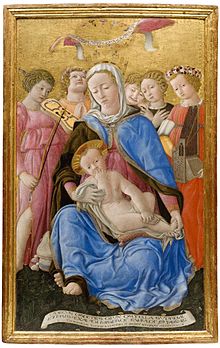
Madonna of humility
by
Domenico di Bartolo
, 1433; one of
the most innovative
Marian images
from the early
Renaissance
.
In the
Catholic Church
, Mary is accorded the title
“Blessed,” (from Latin
beatus, blessed, via
Greek
μακάριος, makarios and Latin
facere, make) in recognition of her
ascension
to Heaven and her capacity to
intercede on behalf of those who pray to her. Catholic teachings make clear that
Mary is not considered divine and prayers to her are not answered by her, they
are answered by God.[106]
The
four Catholic dogmas
regarding Mary are:
Mother of God
,
Perpetual virginity of Mary
,
Immaculate Conception
(of Mary) and
Assumption of Mary.
The
Blessed Virgin Mary
, the mother of Jesus
has a more central role in Roman Catholic teachings and beliefs than in any
other major Christian group. Not only do Roman Catholics have more theological
doctrines and teachings that relate to Mary, but they have more festivals,
prayers, devotional, and venerative practices than any other group. The
Catholic Catechism
states: “The Church’s
devotion to the Blessed Virgin is intrinsic to Christian worship.”
For centuries, Roman Catholics have performed acts of
consecration and entrustment to Mary
at
personal, societal and regional levels. These acts may be directed to the Virgin
herself, to the
Immaculate Heart of Mary
and to the
Immaculata
. In Catholic teachings, consecration
to Mary does not diminish or substitute the love of God, but enhances it, for
all consecration is ultimately made to God.
Following the growth of Marian devotions in the 16th century, Catholic saints
wrote books such as
Glories of Mary
and
True Devotion to Mary
that emphasized Marian
veneration and taught that “the path to Jesus is through Mary”. Marian devotions
are at times linked to
Christocentric
devotions, e.g. the
Alliance of the Hearts of Jesus and Mary
.[113]

The chapel based on the claimed
House of Mary
in Ephesus
Key Marian devotions include:
Seven Sorrows of Mary
,
Rosary and scapular
,
Miraculous Medal
and
Reparations to Mary
. The months of May and
October are traditionally “Marian months” for Roman Catholics, e.g. the daily
Rosary
is encouraged in October and in
May Marian devotions
take place in many
regions. Popes have issued a number of
Marian encyclicals and Apostolic Letters
to
encourage devotions to and the veneration of the Virgin Mary.
Catholics place high emphasis on Mary’s roles as protector and intercessor
and the
Catholic Catechism
refers to Mary as the
“Mother of God to whose protection the faithful fly in all their dangers and
needs” Key Marian prayers include:
Hail Mary
,
Alma Redemptoris Mater
,
Sub Tuum Praesidum
,
Ave Maris Stella
,
Regina Coeli
,
Ave Regina Coelorum
and the
Magnificat
.
Mary’s participation in the processes of
salvation
and redemption has also been
emphasized in the Catholic tradition, but they are not doctrines.[125][126][127][128]
Pope John Paul II
‘s 1987 encyclical
Redemptoris Mater
began with the sentence:
“The Mother of the Redeemer has a precise place in the plan of salvation.”
In the 20th century both popes John Paul II and
Benedict XVI
have emphasized the Marian focus
of the Church. Cardinal
Joseph Ratzinger
(later Pope Benedict XVI)
wrote:
It is necessary to go back to Mary if we want to return to that “truth
about Jesus Christ,” “truth about the Church” and “truth about man”.
when he suggested a redirection of the whole Church towards the program of
Pope John Paul II in order to ensure an authentic approach to
Christology
via a return to the “whole truth
about Mary”.
Orthodox view
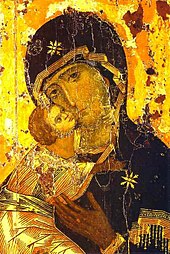
Our Lady of Vladimir
, one of the
holiest medieval representations of the
Theotokos
Orthodox Christianity
includes a large number
of traditions regarding the Ever Virgin Mary, the
Theotokos
. The Orthodox believe that she was
and remained a virgin before and after Christ’s birth. The
Theotokia
(i.e.
hymns to the Theotokos
) are an essential part
of the
Divine Services
in the
Eastern Church
and their positioning within the
liturgical sequence effectively places the Theotokos in the most prominent place
after Christ. Within the Orthodox tradition, the order of the saints begins
with: The Theotokos, Angels, Prophets, Apostles, Fathers, Martyres, etc. giving
the Virgin Mary precedence over the angels. She is also proclaimed as the “Lady
of the Angels”.
The views of the
Church Fathers
still play an important role in
the shaping of Orthodox Marian perspective. However, the Orthodox views on Mary
are mostly doxological
, rather than academic: they are
expressed in hymns, praise, liturgical poetry and the veneration of icons. One
of the most loved Orthodox
Akathists
(i.e.
standing hymns
) is devoted to Mary and it is
often simply called the
Akathist Hymn
. Five of the twelve
Great Feasts
in Orthodoxy are dedicated to
Mary.The
Sunday of Orthodoxy
directly links the Virgin
Mary’s identity as Mother of God with icon veneration. A number of Orthodox
feasts are connected with the miraculous icons of the Theotokos.
The Orthodox view Mary as “superior to all created beings”, although not
divine. The Orthodox venerate Mary as conceived immaculate and assumed into
heaven, but they do not accept the Roman Catholic dogmas on these doctrines. The
Orthodox celebrate the
Dormition of the Theotokos
, rather than
Assumption.
The
Protoevangelium of James
, an
extra-canonical
book, has been the source of
many Orthodox beliefs on Mary. The account of Mary’s life presented includes her
consecration as a virgin at the temple at age three. The
High Priest
Zachariah blessed Mary and informed
her that God had magnified her name among many generations. Zachariah placed
Mary on the third step of the altar, whereby God gave her grace. While in the
temple, Mary was miraculously fed by an angel, until she was twelve years old.
At that point an angel told Zachariah to betroth Mary to a widower in Israel,
who would be indicated. This story provides the theme of many hymns for the
Feast of
Presentation of Mary
, and icons of the feast
depict the story. The Orthodox believe that Mary was instrumental in the growth
of Christianity during the life of Jesus, and after his Crucifixion, and
Orthodox Theologian
Sergei Bulgakov
wrote: “The Virgin Mary is the
center, invisible, but real, of the Apostolic Church”
Theologians from the Orthodox tradition have made prominent contributions to
the development of Marian thought and devotion.
John Damascene
(c 650─c 750) was one of the
greatest Orthodox theologians. Among other Marian writings, he proclaimed the
essential nature of Mary’s heavenly Assumption or Dormition and her mediative
role.
It was necessary that the body of the one who preserved her virginity
intact in giving birth should also be kept incorrupt after death. It was
necessary that she, who carried the Creator in her womb when he was a baby,
should dwell among the tabernacles of heaven.
From her we have harvested the grape of life; from her we have cultivated
the seed of immortality. For our sake she became Mediatrix of all blessings;
in her God became man, and man became God.
More recently,
Sergei Bulgakov
expressed the Orthodox
sentiments towards Mary as follows:
Mary is not merely the instrument, but the direct positive condition of
the Incarnation, its human aspect. Christ could not have been incarnate by
some mechanical process, violating human nature. It was necessary for that
nature itself to say for itself, by the mouth of the most pure human being:
“Behold the handmaid of the Lord, be it unto me according to Thy word.”
Protestant view
Protestants in general reject the veneration and invocation of the Saints.
Protestants typically hold that Mary was the mother of Jesus, but was an
ordinary woman devoted to God. Therefore, there is virtually no Marian
veneration, Marian feasts, Marian pilgrimages, Marian art, Marian music or
Marian spirituality in today’s Protestant communities. Within these views, Roman
Catholic beliefs and practices are at times rejected, e.g., theologian
Karl Barth
wrote that “the heresy of the
Catholic Church is its
Mariology
“.
Some early Protestants venerated and honored Mary.
Martin Luther
wrote that: “Mary is full of
grace, proclaimed to be entirely without sin. God’s grace fills her with
everything good and makes her devoid of all evil”. However, as of 1532 Luther
stopped celebrating the feast of the
Assumption of Mary
and also discontinued his
support of the
Immaculate Conception
.
In the text of the
Magnificat
(recorded in
Luke 1:46-55
), Mary proclaims “My
soul rejoices in God my Savior”. The personal need of a savior is seen by
Protestants as expressing that Mary never thought herself “sinnless”.
John Calvin
said, “It cannot be denied that God
in choosing and destining Mary to be the Mother of his Son, granted her the
highest honor. However, Calvin firmly rejected the notion that anyone but Christ
can intercede for man.
Although Calvin and
Huldrych Zwingli
honored Mary as the Mother of
God in the 16th century, they did so less than Martin Luther. Thus the idea of
respect and high honor for Mary was not rejected by the first Protestants; but,
they came to criticize the Roman Catholics for venerating Mary. Following the
Council of Trent
in the 16th century, as Marian
veneration became associated with Catholics, Protestant interest in Mary
decreased. During the Age of the Enlightenment any residual interest in Mary
within Protestant churches almost disappeared, although Anglicans and Lutherans
continued to honor her.
Protestants acknowledge that Mary is “blessed among women”
but they do not agree that Mary is to be venerated. She is considered to be an
outstanding example of a life dedicated to God.
In the 20th century, Protestants reacted in opposition to the Catholic dogma
of the
Assumption of Mary
. The conservative tone of
the
Second Vatican Council
began to mend the
ecumenical differences, and Protestants began to show interest in Marian themes.
In 1997 and 1998 ecumenical dialogs between Catholics and Protestants took
place, but to date the majority of Protestants pay scant attention to Marian
issues and often view them as a challenge to the
authority of Scripture
.
Other views
Pagan Rome
From the early stages of Christianity, belief in the virginity of Mary and
the virgin conception of Jesus, as stated in the gospels, holy and supernatural,
was used by detractors, both political and religious, as a topic for
discussions, debates and writings, specifically aimed to challenge the divinity
of Jesus and thus Christians and Christianity alike. In the 2nd century, as part
of the earliest anti-Christian polemics,
Celsus
suggested that Jesus was the
illegitimate son of a Roman soldier named Panthera. The views of Celsus drew
responses from Origen
, the Church Father in
Alexandria, Egypt
who considered it a
fabricated story. How far Celsus sourced his view from Jewish sources remains a
subject of discussion.
In Judaism
The issue of the parentage of
Jesus in the Talmud
affects also the view of
his mother. However the Talmud does not mention Mary by name and is considerate
rather than only polemic. The story about Panthera is also found the
Toledot Yeshu
, the literary origins of which
can not be traced with any certainty and given that it is unlikely to go before
the 4th century, it is far too late to include authentic remembrances of Jesus.
The Blackwell Companion to Jesus states that the Toledot Yeshu has no historical
facts as such, and was perhaps created as a tool for warding off conversions to
Christianity. The name Panthera may be a distortion of the term parthenos
(virgin) and
Raymond E. Brown
considers the story of
Panthera a fanciful explanation of the birth of Jesus which includes very little
historical evidence.
Robert Van Voorst
states that given that
Toledot Yeshu is a medieval document and due to its lack of a fixed form and
orientation towards a popular audience, it is “most unlikely” to have reliable
historical information.
|






 of the 12th century who reigned over a crucial turning
of the 12th century who reigned over a crucial turning











